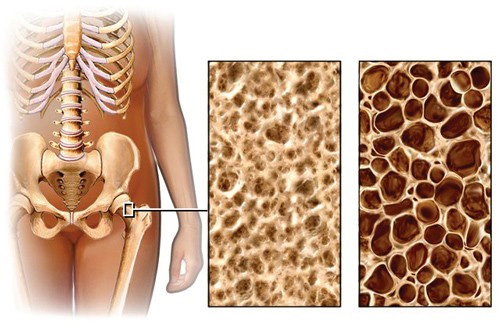Osteoporosis is a disease, characterized by an advanced decrease of bone density, i.e. the amount of bone substance per bone unit volume. The chemical constitution of the bones does not change. Decreased bone density reduces their strength and increases the probability of fractures. Thus, about 70% of fractures in patients older than 50 years can be attributed to the consequences of osteoporosis. Over a lifetime, the bone tissue is constantly being regenerating, i.e. old tissue is gradually destroyed, resorbed and replaced with a new one. Osteoporosis is the result of an imbalance between the process of synthesis and destruction, which leads to a significant bone tissue mass reduction.
Reduced bone density leads to increased probability of fractures. A characteristic feature of osteoporotic fractures is that they happen even because of light loads. That ease of fractures is a major risk of having osteoporosis, as essential bone structures of a human body may be broken, such as the spine, hip. Fractures lead to immobilization of the patient, which in old age is fraught with considerable number of complications – from bed sores to the development of congestive pneumonia, which can be life-threatening. Few people know this fact, but osteoporosis is now the fourth most common cause of death – it gives way only to cardiovascular diseases, tumors and diabetes. And hip fracture is considered to be the main cause of death in patients with this diagnosis.
Risk Factors
All the risk factors are divided into two groups: controllable risk factors (they depend on the lifestyle and behavior and may be eliminated), and uncontrollable risk factors (which do not depend on a person).
1. Uncontrollable risk factors
– female sex (women are much more susceptible to this disease than men);
– race (Asian women have osteoporosis more often);
– age of 65 and above (with age, the probability of disease development increases significantly); – immediate family having osteoporosis and/or fractures which were caused by light load (injury) at the age of 50 and above (a genetic predisposition to this disease is very important);
– previous fractures;
– some endocrine diseases;
– early (including surgical) menopause;
– low body-mass index and/or low weight;
– low mobility (immobilization, fixation of the patient’s body or limb in case of injuries, significant weight of the patient, psychiatric disorders complicating the movement – all these states may be the causes of osteoporosis).
2. Controllable risk factors
– calcium deficiency (people at the age of 50 and above need about 1200 mg of calcium per day (but not more than 2500 mg));
– vitamin D deficiency (Our body needs vitamin D to absorb calcium. Usually most people get enough vitamin D from staying in the sun for about 20 minutes a day. We also get it from some food (eggs, some fish, cereals…). At the age between 51 and 70 you need 400 IU, and over age 70 – 600 IU per day.) But you should be careful with using calcium and vitamin D supplements, as overuse of them may cause some side effects. Thus, better consult your doctor first, if you think that you get not enough calcium or vitamin D.
– smoking;
– excessive intake of caffeine-containing beverages and alcohol;
– low physical activity;
– predisposition to falling.
Patient can and must change all these factors to decrease the possibility of the development of such a dangerous disease.
Symptoms of Osteoporosis
It is quite difficult to distinguish this disease it early stages, though there are several signs of it. For example, changes in posture, pain in bones during the weather change, brittle hair and nails, dental decay. The most susceptible to this disease are the spine, hip, bones of the hands and wrist.
The first symptoms of osteoporosis can be pain in lumbar and dorsal spine during long-term static load (for example, sedentary work), leg cramp at night time, brittle nails, age-related declining posture, loss of height (due to reduction of the spine bones height), the phenomenon of periodontal disease.
Diagnosis of Osteoporosis
A particular deceit of osteoporosis is that it is delitescent for quite a long time and is diagnosed most often only after appearance of its complications – fractures. Modern medicine has a very effective method for the detection of osteoporosis in the early stages, when the reduction in bone density does not exceed 3-5%. It is called DEXA-scan or dual-energy x-ray absorptiometry. This test allows determining the bone density and predicting the risk of fractures.
Prevention of Osteoporosis
The prevention of osteoporosis should be started as early as possible. A huge role in the prevention of osteoporosis plays quitting such bad habits as smoking and alcohol overuse.
Physical activity and adequate load on all the bones of the skeleton is one of the major and very effective methods to prevent the bone tissue density reduction (osteopenia). Bone density is directly dependent on the physical load on the bones. The most rapid reduction of the bone mass is observed in astronauts in weightlessness and in people confined to bed.
Another important factor in the prevention of osteoporosis is the observance of Nutrition Hygiene. Sensible nutrition and balanced diet are essential for the normal functioning of the digestive system, proper metabolism, and strengthening of immune system. However, the main cause of osteoporosis is a violation of metabolic and hormonal processes in the body.
Special diet
For proper nutrition, first of all, you need to eat foods containing calcium and vitamin D. They can be found in the variety of dairy products (allergic people can use soy, goat or nut milk), fish, greens, cabbage, broccoli, nuts. Vitamin D is found in fish, fish oil, and eggs. In addition, sun also contributes to the production of vitamin D.




